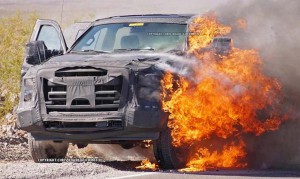
A fire rapidly spreads across a Ford Super Duty pickup prototype undergoing tests in Death Valley. Photo Courtesy Chris Doane Automotive.
The last thing Ford can afford is to see the upcoming launch of its radical new, aluminum-bodied F-Series pickup go up in flames. But that was precisely what happened to a prototype during testing in Death Valley.
According to spy photographer Chris Doane, who caught a camouflaged version of the pickup, it took just 21 minutes for the pickup to be completely reduced to a pile of ashes and metal.
The truck that burned was apparently a 2016 Ford Super Duty, not the new 2015 F-150 that has already been shown in its uncovered form since its introduction at the Detroit Auto Show last January. But while Ford has yet to provide specific details, it is expected that the Super Duty line will switch to an aluminum body a year after the more mainstream F-150.
Two engineers riding in the Super Duty prototype exited the vehicle before it was consumed, and reportedly appeared uninjured.
According to a report from Autoblog.com, “The fire appears to have started in the driver-side front wheel well, spreading to engulf the entire front end in three minutes.”
Precisely what happened and why remains to be seen. But it is not entirely unusual for engineers to experience problems during prototype testing. In fact, a new Acura NSX supercar was destroyed last month while running laps on the grueling Nurburgring near Cologne, Germany.
(GM bans engineers from talking about “death traps,” “powder kegs” and “defects.” Click Here for more.)
Part of the problem is that engineers are often making changes on the fly and some of those can cause unexpected problems. Further complicating matter, the Ford Super Duty, like many prototypes, was wrapped in heavy camouflage that can limit a vehicle’s breathing and cooling capabilities – and which even can catch fire on its own.
But Ford can’t afford any bad news when it comes to the new F-150 or later models that might also adopt the “aluminum-intensive” design. The F-Series, on the whole, is not only Ford’s best-selling model but the single top-seller in the U.S. market, volumes routinely topping 700,000 and, at one point nudging 1 million in a single year.
But there have been a lot of concerns raised about the durability and reliability of the new approach, along with questions about maintenance costs. Ford has been actively campaigning to overcome such worries, something the images of the Super Duty fire might just fan.
A Ford spokesperson has confirmed that, “While testing an experimental vehicle in Death Valley, there was a fire. We are investigating.” Other details remain to be seen.
Vehicle fires are far from uncommon, with an average of 152,300 a year reported between 2006 to 2010, according to the National Fire Protection Association. All told, they caused 209 deaths, 764 injuries and $536 million in direct property damage.
For an automaker, a fire can be particularly problematic. Chrysler last year reluctantly agreed to recall millions of older Jeeps because of a potential fire risk in a rear crash. And it recalled another 895,000 due to a potential fire hazard last month.
(Click Herefor more on the latest recall.)
Earlier this year, meanwhile, start-up Tesla Motors modified the underbody of its Model S battery-electric vehicle after several caught fire following collisions with road debris.
(For more on Tesla’s fix for the Model S, Click Here.)

Yep, aluminum burns real good. Anyone remember the Falklands war?
As a kid I did not think any metal could burn. I had some aluminum with tar on it, the scrap market would not want it at the time. My grandfather threw it in the burn pile and it was very quickly consumed. Might as well make a magnesium truck why not?
Engineers are making goofy stuff these days. I love plumbing parts made of zinc that react to water.
There is the upside that when aluminum burns, the gas generated, along with common smoke, is quite toxic. Ford will only lose customers with an aluminum bodied truck. I’ll keep up the maintenance and repair on my ’69 Ford F-250. There is nothing on that truck which that I cannot perform myself with common tools.